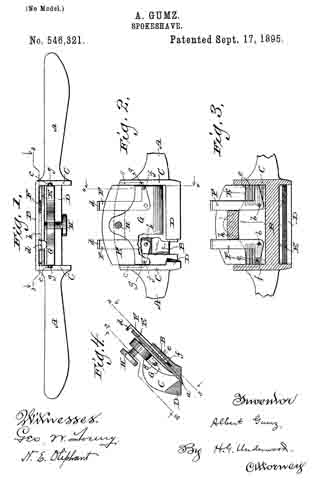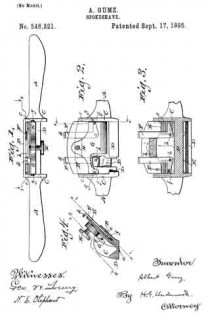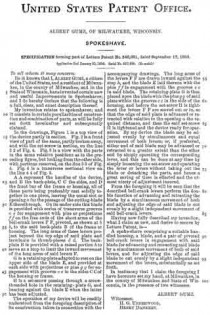No. 546,321 – Spokeshave (Albert Gumz) (1895)

UNITED STATES PATENT OFFICE.
_________________
ALBERT GUMZ, OF MILWAUKEE, WISCONSIN.
SPOKESHAVE.
_________________
SPECIFICATION forming part of Letters Patent No. 546,321, dated September 17, 1895.
Application filed January 20, 1894. Serial No. 497,499. (No model.)
_________________
To all whom it may concern:
Be it known that l, ALBERT GUMZ, a citizen of the United States, and a resident of Milwaukee, in the county of Milwaukee, and in the State of Wisconsin, have invented certain new and useful Improvements in Spokeshaves; and I do hereby declare that the following is a full, clear, and exact description thereof.
My invention relates to spokeshaves; and it consists in certain peculiarities of construction and combination of parts, as will be fully set forth hereinafter and subsequently claimed.
In the drawings, Figure 1 is a top view of the device partly in section. Fig. 2 is a front view of part of the same, partly broken away, and with the set-screw in section, on the line 2 2 of Fig. 4. Fig. 3 is a view with the parts in the same relative positions as in the preceding figure, but looking from the other side, with portions removed, on the line 3 3 of Fig. 4. Fig. 4 is a transverse sectional view on the line 4 4; of Fig. 2.
A A represent the handles of the device, and B the back-plate, C C the sides, and D the front bar of the frame or housing, all of these parts being preferably cast solidly together in one piece, leaving the usual slot or opening a for the passage of the cutting-blade E therethrough. On its under side this blade is provided with series of transverse grooves e e for engagement with pins or projections f f on the free ends of the short arms of the bell-crank levers F F, pivoted, as shown at b b, to the said back-plate B of the frame or housing. The long arms of these levers project beyond the top edge of said plate and terminate in thumb-pieces d d. The back-plate B is provided with a raised portion h to serve as a stop to limit the inward movement of the long arms of said levers F.
G is a retaining-plate adapted to rest on the upper side of the blade E, and provided at each side with projections or pins g g for engagement vvith grooves c c in the sides C C of the housing or frame.
H is a set-screw passing through a screw-threaded hole in the retaining-plate G, and bearing against the blade E when the latter has been adjusted.
The operation of my device will be readily understood from the foregoing description of its construction taken in connection with the accompanying drawings. The long arms of the levers F F are drawn inward against the stop h, and the blade E laid thereon with the pins f f in engagement with the grooves c c in said blade. The retaining-plate G is then placed upon the blade with the pins g g of said plate within the grooves c c in the side of the housing, and before the set-screw H is tightened the levers F F are moved out or in, so that the edge of said plate is advanced or retracted with relation to the opening on the required distance, and then the said set-screw H is tightened and the device ready for operation. By my device the blade may be adjusted evenly by simultaneous and equal movement of both levers; or, if preferred, either end of said blade may be advanced or retracted to a greater extent than the other end by simply operating the corresponding lever, and this can be done at any time by simply loosening the set-screw and operating the lever or levers without taking out the blade or detaching the parts, and hence a great saving of time is effected and the utmost nicety of adjustment insured.
From the foregoing it will be seen that the described bell-crank levers perform the double function of advancing and retracting the blade by a simultaneous movement of both and adjusting the edge of said blade to cut evenly by a slight independent movement of said beli-crank levers.
Having new fully described my invention, what I claim as new, and desire to secure by Letters Patent, is —
A spokeshave comprising a suitable handled housing, a blade, and a pair of pivoted bell-crank levers in engagement with said blade for advancing and retracting said blade by a simultaneous movement of both of said levers, and for adjusting the edge of said blade to cut evenly by a slight independent movement of the levers, substantially as set forth.
In testimony that I claim the foregoing I have hereunto set my hand, at Milwaukee, in the county of Milwaukee and State of Wisconsin, in the presence of two witnesses.
ALBERT GUMZ.
Witnesses:
H. G. UNDERWOOD,
HENRY DANKERT.


